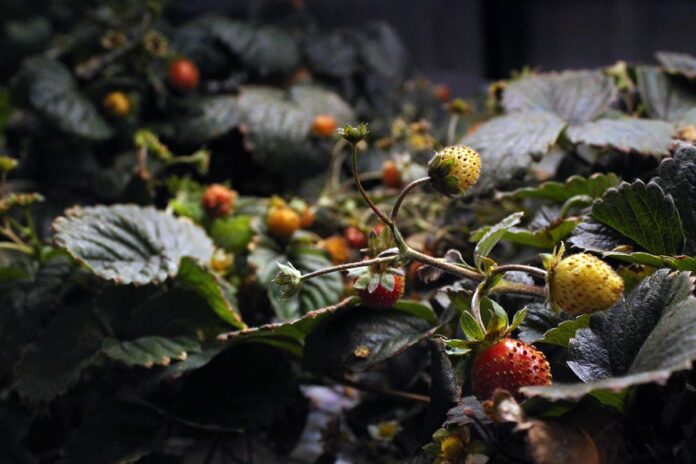Is there anything better than a fresh strawberry? For the average American that consumes around eight pounds of strawberries per year, there’s not much that beats these sweet fruits.
For hydroponic farmers, strawberries are a great choice. While these self-pollinating fruits can present challenges for beginner growers, they’re a rewarding and potentially lucrative crop that’s always in demand.
In this blog, we’ll cover what you need to know about how to grow hydroponic strawberries, from EC and pH to the ideal lighting scheduling and the best varieties to grow in a hydroponic system.
The Essentials You Need to Know to Grow Hydroponic Strawberries
Strawberries are a versatile and popular fruit that can be grown successfully in a hydroponic system. One of the key aspects of growing strawberries hydroponically is understanding the importance of runners.
Runners are horizontal stems that grow from strawberry plants and produce new plants at their tips. While some growers might think to cut these runners, that might be a bad decision if you’re looking to optimize yield. Allowing runners to grow can increase the number of fruit-bearing plants, leading to a higher overall yield.

EC and pH Balance
Maintaining the correct electrical conductivity (EC) and pH levels is crucial for the health and productivity of hydroponic strawberries. The ideal EC range for strawberries is between 1.3 and 2.5 mS/cm. This range ensures that the plants receive the right amount of nutrients without experiencing nutrient burn or deficiencies.
The pH level of the nutrient solution should be kept between 5.5 and 6.5. This slightly acidic range allows the plants to absorb essential nutrients effectively. Regular monitoring and adjustment of the pH and EC levels are necessary to ensure optimal growth conditions. Cucumbers and Peppers also grow well in this range, making them good neighbors for hydroponic strawberries in your grow system.
Lighting Scheduling
Strawberries grow best with at least 12-14 hours of direct light per day. Depending on the type of strawberry, you may want to adjust the lighting schedule to encourage fruiting. For example, everbearing and day-neutral varieties benefit from consistent lighting schedules, while June-bearing varieties may require adjustments to simulate seasonal changes.
Using LED grow lights can provide the necessary light spectrum for strawberry plants. These lights are energy-efficient and can be adjusted to provide the right intensity and duration of light.
Ensuring that your strawberries receive adequate light promotes healthy growth and increase fruit production.

Temperature Window
Strawberry plants typically grow well in warm to hot temperatures during the day and cool to mildly warm nights. The ideal temperature range for strawberries is between 60°F and 80°F (15°C to 27°C) during the day and 55°F to 65°F (13°C to 18°C) at night. Maintaining this temperature range helps to optimize growth and fruit development.
In a container farm, temperature control can be achieved through the use of heating and cooling systems. Monitoring the temperature and making adjustments as needed will ensure that your strawberries thrive in their hydroponic environment.
Hand Pollinating Hydroponic Strawberries
In nature, strawberries get help with pollinating through the help of pollinators like wild bees, flies, butterflies, and even beetles. However, in a controlled hydroponic environment, natural pollinators may not be present. To ensure successful pollination, you can hand-pollinate your strawberry plants.
Hand pollination involves gently transferring pollen from the male parts (anthers) of the flower to the female parts (stigma). This can be done using a small brush or cotton swab. Regularly hand-pollinating your strawberry plants will increase the chances of fruit set and improve overall yield.

The Best Varieties of Hydroponic Strawberries
The best varieties of hydroponic strawberries are those that fruit multiple times a year, such as everbearing and day-neutral varieties. These varieties produce fruit in the spring, late summer and fall, providing a continuous harvest throughout the growing season.
June-bearing varieties of strawberries don’t fruit within the first year. This can be a challenge for hydroponic farmers that need to turn a profit quickly or meet unexpected demand. For this reason, we recommend using day-neutral strawberry varieties, which grow fruit in the first year of cultivation.
The Difference Between Single-Bearing Varieties and Multi-Bearing Varieties
Single-bearing varieties, also known as June-bearing varieties, produce a large crop of strawberries once a year, typically in late spring or early summer. While these varieties can produce a high yield, they may not be suitable for hydroponic systems that require continuous production.
Multi-bearing varieties, such as everbearing and day-neutral strawberries, produce fruit multiple times a year. Everbearing varieties typically produce two to three harvests per year, while day-neutral varieties can produce fruit continuously throughout the growing season. These varieties are ideal for hydroponic systems, as they provide a steady supply of strawberries.

The Benefits of Growing Hydroponic Strawberries in a Container Farm
Growing hydroponic strawberries in a container farm offers several benefits. First, it allows for year-round production, regardless of external weather conditions. This means you can provide fresh strawberries to your customers even in the off-season.
Second, container farms offer a controlled environment, which reduces the risk of pests and diseases. This leads to healthier plants and higher-quality fruit. Additionally, hydroponic systems use water more efficiently than traditional soil-based methods, reducing water consumption and making your farm more sustainable.
Finally, container farms can be set up in urban areas, bringing fresh produce closer to consumers. This reduces transportation costs and carbon emissions, making your operation more environmentally friendly, and results in fresher strawberries for customers.
Summary
Growing hydroponic strawberries in a Pure Greens container farm is a rewarding and potentially lucrative endeavor. By understanding the essentials of strawberry cultivation, including EC and pH balance, lighting scheduling, temperature control and hand pollination techniques, you can optimize your yield and produce high-quality fruit, anywhere in the world with a secure power connection.

